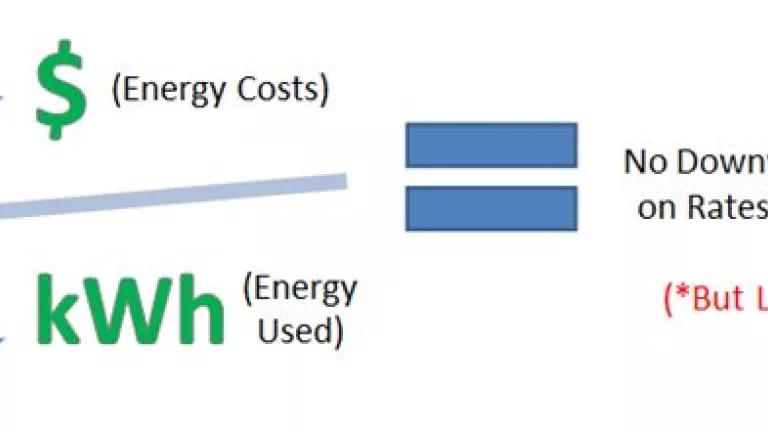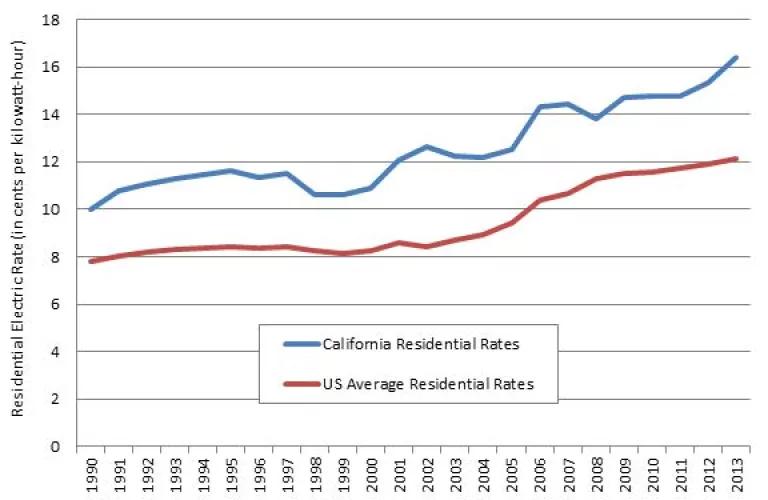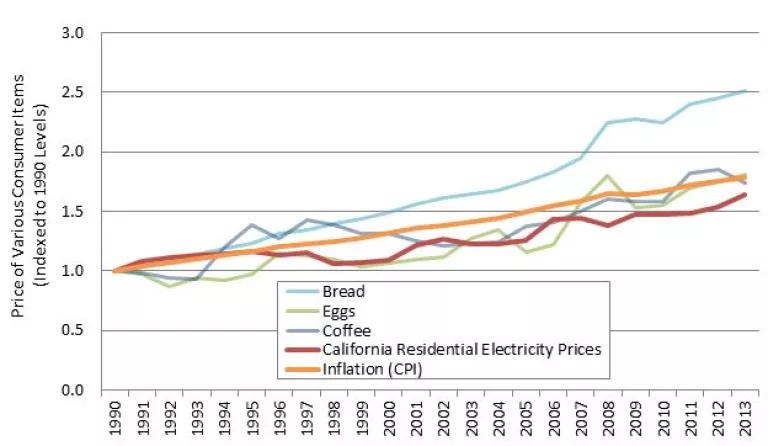
Despite all the facts, the myth that Californians pay a lot of money for their electricity every month continues to be perpetuated, with its proponents using their misguided interpretation of the data to justify their claim that California shouldn’t be the model for developing a clean energy future.
This time around, it was a Forbes blog contributor who fell for the same misconception, mistakenly claiming that California’s clean energy progress is too expensive and shouldn’t be a model for ways to cut America’s emissions from existing power plants.
But the reality is that California is cleaning up its electricity act—while at the same time—maintaining extremely low residential bills and merely normal growth in prices.
Californians know this is true – the money coming out of their pockets to pay for electricity is much less than most places in the nation. But I’m not writing to tell California utility bill payers something they already know. I’m writing because other people are twisting the facts, and proffering them as reasons to thwart America’s progress toward cleaner energy and less climate-disrupting pollution.
California ranks high in low bills
Let’s get something out of the way: California residents pay an average monthly electric bill that is lower than all but nine other states in the union. You heard that right. Despite all the rhetoric about how expensive it’s been for California to make progress on clean energy, if you are an average American, your California counterpart pays a lower electric bill than you.
How is that possible? One of the main reasons why California has been able to maintain its low residential electric bills is that it invests so heavily in energy efficiency—finding ways to support smarter use of energy like upgrading old leaky homes and setting better standards for energy-guzzling appliances. This energy efficiency is cheaper than all the other types of energy, so it keeps California’s electric bills low. (In other words, if we use less electricity, utilities don’t have to generate as much of it, which keeps everyone’s costs low – and reduces the emissions that come along with making it.)
There’s a big difference between rates and bills
One technical aspect of energy efficiency is that it puts downward pressure on people’s electric bills, but it doesn’t apply the same kind of pressure to the price of electricity (or “rate”), which usually shows up on our bills as cents per kilowatt-hour (a unit of electricity). [Caveat lector: to avoid the boring stuff, skip to next paragraph.] Electric rates/prices are a function of the costs incurred to meet our electricity needs spread over how much electricity is used. (Numerically, this means an equation of costs over units of energy). Energy efficiency does reduce the cost of that electricity, which cuts the total amount of money being charged. But energy efficiency also leads to fewer kilowatt-hours used. Because both the numerator and the denominator of the rate equation decrease, as you can see in this illustration. energy efficiency doesn’t result in downward pressure on the rate.
However, because Californians optimize their energy use through efficiency improvements, they use many fewer of those kilowatt hours of electricity than they would otherwise. The result: LOWER BILLS. And isn’t that what people care about? I can’t think of a single person who would trade a lower bill for a lower rate.
Now, people who fail to grasp the importance of electric bills often latch onto prices, and the fact that California’s electric rates are higher than the rest of the country – rather than looking at how much Californians actually PAY for electricity. Sometimes these naysayers even try to tie (unsuccessfully) these high rates to the idea that California’s environmental progress in the energy space must end. That’s what happened in the incorrect Forbes opinion piece – but it took a leap that just doesn’t exist.
California electricity prices growing on par with the U.S.
The Forbes contributor measured the growth in California electric rates since 2003, altered the vertical axis, and omitted any reference to what’s happening generally in the country. All this made it appear like California rates are skyrocketing.
But here’s the truth: California rates have been rising less quickly than national rates since 2003. All you need is a ruler and you can see that residential rates have risen somewhat less in California than in the United States since 2003 (34 percent compared to 39 percent, respectively). By only showing the California increase, the Forbes article ignored the general phenomenon of increasing prices around the country.

Source: U.S. Energy Information Administration (2014).
California annual growth rates similar to U.S. rates
The contributor’s additional claim that the growth in California’s electricity prices has quadrupled since 2003 is both false and misleading. It’s also a classic example of portending a doomsday end to California’s progress on clean energy by exaggerating statistics. Just take a look at the raw price data above – there’s no quadrupling of anything related to electricity prices over the last quarter-century. The truth is that over the long run, both California and the United States experienced moderate increases in electricity prices, rising at about the same pace as inflation (rising around 2% compound annual growth rate since 1990). By comparison, something like the nominal price of gasoline has tripled over the same period, (or grew at over 5% compound annual growth since then).
Here’s how Californian’s electricity prices stack up against inflation of the price of some other commonly purchased items:

Source: U.S. Bureau of Labor Statistics, U.S. Energy Information Administration (2014).
As you can see, California electricity rates have increased below the rate of inflation and the prices for coffee, eggs and bread.
The big picture
What’s really happening in California is that one of the nation’s most creative suite of initiatives to tackle climate change is working. California is investing unparalleled sums of money into clean energy like solar panels and wind turbines (which produce electricity without polluting the air), and at the same time helping cut energy waste in our homes and businesses. This powerful combination allows a state to both clean up its energy supply and keep electric bills low for its residents. And it shows in California‘s story: electricity consumption per person in the state of California is lower now than it was in 1973. As a result, Californians have some of the lowest electric bills in the country, and electric rates that grow at a normal pace. (Let’s also not forget those significant byproducts of creating clean energy jobs and a healthier economy, either.)
So don’t let the naysayers scare you into believing that California’s successful clean energy policies are too experimental or too expensive—they’re not.
The real experiment is the one occurring in the earth’s atmosphere right now due in large part to the world’s energy use. It’s causing climate-warming pollution and resulting in catastrophic weather events—and that’s a real expense.
